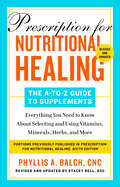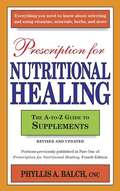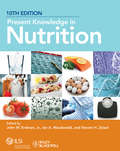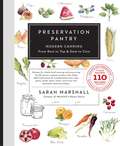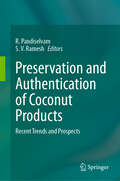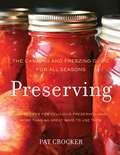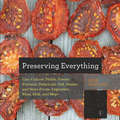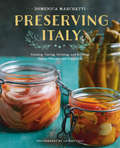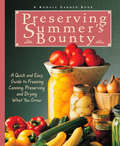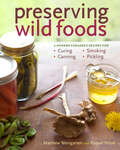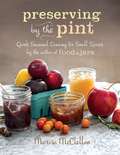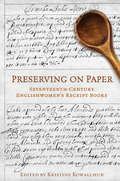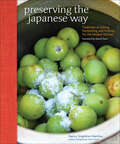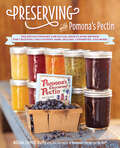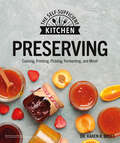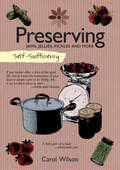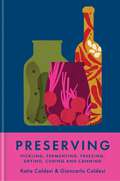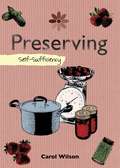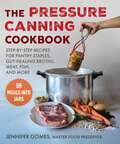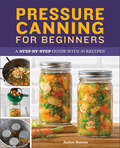- Table View
- List View
Prescription for Nutritional Healing: Everything You Need to Know About Selecting and Using Vitamins, Minerals, Herbs, and More
by Phyllis A. BalchCompletely updated for the twenty-first century—a convenient, pocket-sized edition of the nation&’s most trusted guide to holistic health. For decades, millions of people have turned to Prescription for Nutritional Healing for natural remedies to improve their health. This portable A-to-Z reference guide of the most commonly available types of nutrients, dietary supplements, and herbs puts that information at your fingertips. Drawn from the newly revised Prescription for Nutritional Healing, Sixth Edition, it includes:recent scientific discoveries about vitamins A, C, D, and B12, as well as biotin, coenzyme Q10, and calciumthe newest information on herbs, such as turmeric, ashwagandha, lemongrass, and St.-John&’s-wort; flaxseeds and oils; and sugar substitutes, including stevia and monk fruitup-to-date research on natural approaches to weight lossscience-based information about COVID-19 Whether you are looking for relief from a specific ailment or simply to achieve and maintain optimum health, Prescription for Nutritional Healing: The A-to-Z Guide to Supplements quickly provides access to everything you&’ll need to design a complete nutritional program.
Prescription for Nutritional Healing: The A-to-Z Guide to Supplements
by Phyllis A. BalchThis book gives information on all the most important supplements available today. It details what a particular supplement is, what forms it comes in and how to use it, as well as when not to use it.
Present Knowledge in Nutrition
by Steven H. Zeisel Ian A. Macdonald John W. Erdman Jr.Present Knowledge in Nutrition, 10th Edition provides comprehensive coverage of all aspects of human nutrition, including micronutrients, systems biology, immunity, public health, international nutrition, and diet and disease prevention. <P><P>This definitive reference captures the current state of this vital and dynamic science from an international perspective, featuring nearly 140 expert authors from 14 countries around the world. Now condensed to a single volume, this 10th edition contains new chapters on topics such as epigenetics, metabolomics, and sports nutrition.The remaining chapters have been thoroughly updated to reflect recent developments. Suggested reading lists are now provided for readers wishing to delve further into specific subject areas. An accompanying website provides book owners with access to an image bank of tables and figures as well as any updates the authors may post to their chapters between editions. Now available in both print and electronic formats, the 10th edition will serve as a valuable reference for researchers, health professionals, and policy experts as well as educators and advanced nutrition students.
Presenting Service: The Ultimate Guide for the Foodserivce Professional 2nd edition
by Lendal H. Kotschevar Valentino LucianiA detailed approach to providing service in restaurants and food service operations Service starts when a customer walks into a restaurant and doesn't end until he or she walks out. Presenting Service, Second Edition, is an up-to-date, hands-on guide for managers that presents the essential skills and know-how to direct a foodservice staff through a successful, completely enjoyable dining experience. Packed with checklists, objectives, key terms, and chapter summaries and reviews, this Second Edition features a new chapter on bar and beverage service that includes coverage of specialty coffees as well as insightful cocktail and wine service advice for better serving and recommending alcoholic and nonalcoholic beverages to guests. Other valuable features of this revised edition include: A new chapter on classic service styles, including the techniques of French, Russian, American, English, and Chinese dining A new chapter on table etiquette that contains a historical perspective as well as thorough coverage of etiquette rules concerning special foods and various cultures, such as European, Chinese, Indian, and Middle Eastern dining Customer Service and Foodservice Security boxes that identify tips and best practices for handling customer and security issues A new appendix covering the duties of service workers that explains the responsibilities of the frontline staff, including the host, server, bus person, and bar server
Preservation Pantry: Modern Canning From Root to Top & Stem to Core
by Sarah MarshallSarah Marshall’s Preservation Pantry includes 100+ recipes for whole-food canning and preserving locally grown, organic produce that helps fight food waste by transforming roots, tops, peels, seeds, skins, stems, and cores into beautiful, delicious dishes.When Sarah Marshall started her hot sauce business, Marshall’s Haute Sauce, she noticed that too much of her produce was getting thrown away, so she decided to make it her mission to learn creative uses for food parts that have normally been tossed aside. Through simple, approachable steps, readers will be guided through the process of canning and preserving produce and using parts like carrot and strawberry tops, fennel fronds, beet stems, onion skins, apple cores, Brussels sprout stalks, lemon rinds, and more to make 100+ unique and delicious recipes. Preservation Pantry’s root-to-top, stem-to-core method recycles every part of fruits and vegetables so that farmer’s market produce stays delicious long after the season ends. Whether you’re an experienced homesteader or a novice canner, Marshall shows you how to create recipes for canning and preserving that you can then incorporate into finished dishes. Recipes include: —Ginger Liqueur Spiked Apples —Mango, Rose Petal, and Saffron Jam —Vanilla Bean Lemonade —Habañero Ground Cherry Peach Hot Sauce —Sparkling Wine Poached Pears —Oven Roasted Chicken Thighs with Pickled Tomatoes —Carrot Top Hazelnut Pesto —Coffee Braised Onion Jam And more!
Preservation and Authentication of Coconut Products: Recent Trends and Prospects
by S. V. Ramesh R. PandiselvamCoconut is an important economic crop widely cultivated in island and coastal ecosystems in the tropical and sub-tropical regions of the world. Emerging trends in biochemical characterization have highlighted the nutraceutical and nutritional importance of coconut and its products. However, the short shelf life of these products seriously restricts their market potential. Coconut beverages such as coconut water, inflorescence sap and coconut milk have numerous health promoting nutrients, although the highly perishable nature of coconut beverages and products causes significant post-harvest losses. Conventional thermal technologies implemented by the coconut processing industry affect the heat sensitive nutrients and create a negative impact on the color and flavor profiles of the products. Producers have been looking for an efficient alternative to thermal technologies, although most of the emerging non-thermal technologies such as cold plasma, ozone, pulsed light, UV-light, pulsed electric field and high-pressure processing are in lab scale. It is important to understand the practical application of these technologies at industry scale. Also, it is important to analyze the influence and application of these emerging technologies on the quality profile, safety and shelf-life extension of the products. The adulteration rate in coconut products has been increasing along with their prices, making it vital to understand the application of non-destructive tools for authentication. Preservation and Authentication of Coconut Products: Recent Trends and Prospects offers comprehensive coverage on the application of emerging technologies in coconut and coconut-based products. Present industrial technologies for coconut products and their impact on quality are covered in full, including technologies for each specific product and their challenges and prospects. Non-destructive tools and applications for the quantification of bioactive components and authentication are also explored. This book serves as a one-stop reference for researchers, food technologists, food industry specialists and nutritionists looking to understand the implications of emerging food processing technologies on the quality of coconut products.
Preserving
by Pat CrockerPreserve it! A comprehensive guide to canning and freezing Home canning and freezing are time-honored kitchen skills that are being rediscovered by a new generation of Americans-both for the pleasure of performing these simple activities and for their inherent economy. Now home cooks can take advantage of their local farmer's markets to buy fresh, inexpensive and seasonal produce to enjoy all year round. In Preserving, Pat Crocker offers practical, easy-to-follow information on home canning and freezing to get novices started and inspire experienced hands. Relish it! More than 200 recipes for pickles, chutneys, jams, sauces, curds, relishes and so much more Organized by season and focused on simple but effective concepts, this practical guide offers thorough information on preserving a diverse range of foods for the pantry, from asparagus and blueberries to peaches and winter squash. Here are techniques on canning, jamming and freezing everything from the most basic hot-packed fruit recipes to gorgeous, internationally flavored chutneys and relishes. Filled with safe and detailed instructions, step-by-step photography and more than two hundred recipes, Preserving is a kitchen essential that is sure to become a classic.
Preserving Everything: Can, Culture, Pickle, Freeze, Ferment, Dehydrate, Salt, Smoke, and Store Fruits, Vegetables, Meat, Milk, and More
by Leda MeredithThe ultimate guide to putting up food. How many ways can you preserve a strawberry? You can freeze it, dry it, pickle it, or can it. Milk gets cultured, or fermented, and is preserved as cheese or yogurt. Fish can be smoked, salted, dehydrated, and preserved in oil. Pork becomes jerky. Cucumbers become pickles. There is no end to the magic of food preservation, and in Preserving Everything, Leda Meredith leads readers--both newbies and old hands--in every sort of preservation technique imaginable.
Preserving Food without Freezing or Canning: Traditional Techniques Using Salt, Oil, Sugar, Alcohol, Vinegar, Drying, Cold Storage, and Lactic Fermentation
by Chelsea Green Publishing CompanyMore than 250 easy and enjoyable recipes!&“The methods here [will] inspire us with their resourcefulness, their promise of goodness, and with the idea that we can eat well year around.&”—Deborah MadisonOver 100,00 copies sold!Typical books about preserving garden produce nearly always assume that modern &“kitchen gardeners&” will boil or freeze their vegetables and fruits. Yet here is a book that goes back celebrating traditional but little-known French techniques for storing and preserving edibles in ways that maximize flavor and nutrition.Translated into English, and with a new foreword by Deborah Madison, this book deliberately ignores freezing and high-temperature canning in favor of methods that are superior because they are less costly and more energy-efficient.Inside, you&’ll learn how to:Preserve without nutrient lossPreserve by dryingPreserve with oil, vinegar, salt, and sugarMake sweet-and-sour preservesPreserve with alcoholAs Eliot Coleman says in his foreword to the first edition, &“Food preservation techniques can be divided into two categories: the modern scientific methods that remove the life from food, and the natural &‘poetic&’ methods that maintain or enhance the life in food. The poetic techniques produce… foods that have been celebrated for centuries and are considered gourmet delights today.&”Preserving Food Without Freezing or Canning offers more than 250 easy and enjoyable recipes featuring locally grown and minimally refined ingredients.An essential guide for those who seek healthy food for a healthy world.
Preserving Italy: Canning, Curing, Infusing, and Bottling Italian Flavors and Traditions
by Domenica MarchettiCapture the flavors of Italy with over 150 recipes for conserves, pickles, sauces, liqueurs, and more in this &“engagingly informative&” guide (Elizabeth Minchilli, author of Eating Rome). The notion of preserving shouldn&’t be limited to American jams and jellies, and in this book, Domenica Marchetti puts the focus on the ever-alluring flavors and ingredients of Italy. There, abundant produce and other Mediterranean ingredients lend themselves particularly well to canning, bottling, and other preserving methods. Think of marinated artichokes in olive oil, classic giardiniera, or, of course, the late-summer tradition of putting up tomato sauce. But in this book we get so much more, from Marchetti&’s travels across the regions of Italy to the recipes handed down through her family: sweet and sour peppers, Marsala-spiked apricot jam, lemon-infused olive oil, and her grandmother&’s amarene, sour cherries preserved in alcohol. Beyond canning and pickling, the book also includes recipes for making cheese, curing meats, infusing liqueurs, and even a few confections, plus recipes for finished dishes so you can savor each treasured jar all year long. &“Pack artichokes, peppers and mushrooms in oil. Make deliciously spicy pickles from melon. Even limoncello, mostarda and confections like torrone can come straight from your kitchen... The techniques may have been passed down by generations of nonnas, but they knew what they were doing.&”—Florence Fabricant, The New York Times &“Marchetti elevates preserved food from the role of condiment to center stage.&”—Publishers Weekly
Preserving Summer's Bounty: A Quick And Easy Guide To Freezing, Canning, Preserving, And Drying What You Gro w (Rodale Garden Book Ser.)
by Susan McClure Rodale Food CenterWhen your harvest comes in, turn to Preserving Summer's Bounty for all the answers about what to do with more than 100 fruits and vegetables. Master preserving processes and techniques, including canning, drying, freezing, pickling, juicing, and storing, with easy-to-follow explanations and more than 200 recipes.
Preserving Wild Foods: A Modern Forager's Recipes for Curing, Canning, Smoking & Pickling
by Raquel Pelzel Matthew WeingartenWhether you forage in the wild or at the farmers’ market, you’ll delight in the unique preserves featured in this one-of-a-kind collection. With a reverence for the natural world and all of its edible bounty, Matthew Weingarten and Raquel Pelzel encourage you to explore the ways in which wild ingredients can be transformed into tasty foods through a range of preserving techniques that include canning, smoking, curing, and pickling. Enjoy your own delicious Duck Prosciutto, Dandelion Jelly, Crab Apple Mostrada, and more!
Preserving by the Pint: Quick Seasonal Canning for Small Spaces from the author of Food in Jars
by Marisa McclellanSeasonal Canning in Small Bites Marisa McClellan was an adult in a high-rise in Philadelphia when she rediscovered canning, and found herself under the preserving spell. She grew accustomed to working in large batches since most "vintage” recipes are written to feed a large family, or to use up a farm-size crop, but increasingly, found that smaller batches suited her life better. Working with a quart, a pound, a pint, or a bunch of produce, not a bushel, allows for dabbling in preserving without committing a whole shelf to storing a single type of jam. Preserving by the Pint is meant to be a guide for saving smaller batches from farmer’s markets and produce stands-preserving tricks for stopping time in a jar. McClellan’s recipes offer tastes of unusual preserves like Blueberry Maple Jam, Mustardy Rhubarb Chutney, Sorrel Pesto, and Zucchini Bread and Butter Pickles. Organized seasonally, these pestos, sauces, mostardas, chutneys, butters, jams, jellies, and pickles are speedy, too: some take under an hour, leaving you more time to plan your next batch.
Preserving on Paper: Seventeenth-Century Englishwomen's Receipt Books
by Kristine KowalchukApricot wine and stewed calf’s head, melancholy medicine and "ointment of roses." Welcome to the cookbook Shakespeare would have recognized. Preserving on Paper is a critical edition of three seventeenth-century receipt books–handwritten manuals that included a combination of culinary recipes, medical remedies, and household tips which documented the work of women at home. Kristine Kowalchuk argues that receipt books served as a form of folk writing, where knowledge was shared and passed between generations. These texts played an important role in the history of women’s writing and literacy and contributed greatly to issues of authorship, authority, and book history. Kowalchuk’s revelatory interdisciplinary study offers unique insights into early modern women’s writings and the original sharing economy.
Preserving the Japanese Way: Traditions of Salting, Fermenting, and Pickling for the Modern Kitchen
by Nancy Singleton HachisuThis beautifully illustrated guide by the author of Japanese Farm Food includes essential Japanese pantry tips and 125 recipes. In Preserving the Japanese Way, Nancy Singleton Hachisu offers step-by-step instructions for preserving fruits, vegetables, and fish using the age-old methods of Japanese farmers and fishermen. The recipes feature ingredients easily found in grocery stores or Asian food markets, such as soy sauce, rice vinegar, sake, and koji. Recipes range from the ultratraditional— Umeboshi (Salted Sour Plums), Takuan (Half-Dried Daikon Pickled in Rice Bran), and Hakusai (Fermented Napa Cabbage)— to modern creations like Zucchini Pickled in Shoyu Koji, Turnips Pickled with Sour Plums, and Small Melons in Sake Lees. Hundreds of full-color photos offer a window into the culinary life of Japan, from barrel makers and fish sauce producers to traditional morning pickle markets. More than a simple recipe book, Preserving the Japanese Way is a book about community, seasonality, and ultimately about why both are relevant in our lives today.“This is a gorgeous, thoughtful—dare I say spiritual—guide to the world of Japanese pickling written with clarity and a deep respect for technique and tradition.” —Rick Bayless, author of Authentic Mexican and owner of Frontera Grill
Preserving with Pomona's Pectin: The Revolutionary Low-Sugar, High-Flavor Method for Crafting and Canning Jams, Jellies, Conserves, and More
by Allison Carroll Duffy Pomona's Universal PectinCraft low-sugar, high-flavor jams, jellies, and pie fillings with the updated, expanded edition of the official Pomona’s Pectin cookbook.If you’ve ever made jam or jelly at home, you know most recipes require more sugar than fruit—oftentimes four to seven cups!—causing many people to look for other ways to preserve more naturally and with less sugar. Pomona’s Pectin is the answer to this canning conundrum. Unlike other popular pectins, which are activated by sugar, Pomona’s is a sugar- and preservative-free citrus pectin that does not require sugar to jell.As a result, jams and jellies can be made with less, little, or no sugar at all and also require much less cooking time than traditional recipes, allowing you to create jams that are not only healthier and quicker to make, but filled with more fresh flavor. If you haven’t tried Pomona’s already (prepare to be smitten), you can easily find the pectin at your local natural foods store, hardware store, or online.In this updated and revised edition of Preserving with Pomona’s Pectin, you’ll continue to learn how to use this revolutionary product and method to create marmalades, preserves, conserves, jams, jellies, as well as new recipes for pie fillings and no-sugar options. The recipes, both sweet and savory, include:Classic StrawberryAll-Fruit Cherry-Peach JamCranberry-Habanero JellyVanilla-Plum PreservesGingered Lemon-Fig PreservesSavory Blueberry-Ginger ConserveGraperfruit-Honey MarmaladePear Cardamom Pie FillingAlternative Sweetener Grape JellyAnd many moreFrom crowd favorites to intriguing flavor combinations, you’ll find endless ways to delight your family all year round.
Preserving, Potting & Pickling: Food from the storecupboards of Europe
by Elizabeth LuardElisabeth Luard is an award-winning food writer and a winner of the much coveted Glenfiddich Trophy and is one of the most highly respected cookery writers in Britain today. She is one of the leading authorities on European food and cooking. Her acclaimed writings are often cited as an inspiration by many of today’s leading chefs, as well as home cooks near and far.For centuries the storecupboard was the most important feature in every European castle, house, or hovel. Its contents were jealously guarded and fiercely protected because they represented survival. In Preserving, Potting and Pickling, Elisabeth Luard chooses the best of these larder-store treasures to give recipes for pickles to jams, bottled sauces to potted and dried meats, and directions for drying and storing vegetables, pulses, herbs and fungi. She goes on to present whole meals built around convenience foods such as Portable Soup (the original soup-cube) and the two ketchups – mushroom and tomato – which have provided the secret ingredient for so many of our ancestors' delicious dishes. There are recipes for storable treats like French pain d’epices (better a month or two in the cupboard) and sweets such as the lovely honey-and-almond turrón of Moorish Spain and the marzipan specialties of southern France. Finally the book offers a section on natural home remedies from soothing syrups to herbal teas. Very much a companion volume to her highly acclaimed European Peasant Cookery this treasure trove is illustrated throughout with the author’s own delightful drawings and paintings. Proving once and for all that fast food need not be junk food, Elisabeth Luard will once again enchant her worldwide audience with her enthusiastic celebration of good food and good husbandry. This is a timely and practical tribute to the wisdom of the past.
Preserving: Can it. Freeze it. Pickle it. Preserve it. (The Self-Sufficient Kitchen)
by Karen K. BreesPreserve your foods with time-tested methods. Canning, freezing, and pickling might seem intimidating. But think of these experiences as ways to strengthen your relationship with food by eating more healthfully, enhancing your nutritional intake, eating organically, saving money, and minimizing contamination illnesses. Plus, just imagine giving someone a Mason jar with strawberry jam and being able to say &“I made this.&” With this step-by-step preservation guide, you can impress family and friends for years to come with your homemade goodies. This revision includes: • More than 50 recipes to preserve fruits, vegetables, meats, dairy products, and more • Techniques for canning, freezing, pickling, fermenting, and other preservation methods • Techniques for dehydrating, salting, and smoking foods • Information on food safety and the best preservation methods for specific foods • Expert tips from Dr. Karen K. Brees on how to get the most from your preserving experience Whether this is your first time trying food preservation or you&’re an expert looking for some new recipes to try, Preserving Foods is the book for you!
Preserving: Jams, Jellies, Pickles and More (Self-Sufficiency)
by Carol Wilson&“This is a handy book to keep in your cupboard for Autumn harvest and the excess fruit and vegetables that come your way.&” (The Rural) Preserving fruits and vegetables is a great way to turn home-grown or local produce into delicious treats that can be enjoyed all year round. There are several different preserving methods and all give delicious results. Jams, jellies, fruit butters and curds, bottled fruits, chutneys, pickles and salted vegetables are all practical and economical ways to preserve seasonal produce. And you don&’t need a load of kitchen gadgets and equipment to get started: a heavy-based pan, funnel, sugar thermometer and a selection of glass storage jars are all you need! Ingredients listings, popular fruits and vegetables, sugars and cooking techniques are all explained, along with storage information and helpful hints and tips. This, along with the sixty delicious recipes that follow, make this book your one-stop guide to successful preserving. &“If you hanker after a slice of the good life, like to know the provenance of your food or simply want to be thrifty, this . . . is an excellent place to start.&” —Food and Travel &“A comprehensive look at all aspects of turning home-grown produce into delicious treats.&” —Country Kitchen &“A little gem of a book.&” —Highland Life
Preserving: Pickling, fermenting, freezing, drying, curing and canning
by Katie Caldesi Giancarlo CaldesiKatie and Giancarlo embarked on a two year-long journey to discover the different methods of conserving food, from smoking fish in Scotland to drying chillies in Sri Lanka, and this book collects over 200 of their favourite recipes and invaluable advice on equipment, timings and ingredients. Covering Italian cured charcuterie inspired by Giancarlo's family recipes, jams and chutneys evoking Katie's memories of cooking with her mother to pickling, fermenting, freezing and pressure canning they combine traditional tried-and-tested methods with a thoroughly modern perspective.
Preserving: Pickling, fermenting, freezing, drying, curing and canning
by Katie Caldesi Giancarlo CaldesiKatie and Giancarlo embarked on a two year-long journey to discover the different methods of conserving food, from smoking fish in Scotland to drying chillies in Sri Lanka, and this book collects over 200 of their favourite recipes and invaluable advice on equipment, timings and ingredients. Covering Italian cured charcuterie inspired by Giancarlo's family recipes, jams and chutneys evoking Katie's memories of cooking with her mother to pickling, fermenting, freezing and pressure canning they combine traditional tried-and-tested methods with a thoroughly modern perspective.
Preserving: Self-Sufficiency (Self-Sufficiency Series)
by Carol WilsonThere are several different methods of preserving fruits and vegetables and all give delicious results. Jams, jellies, fruit butters and curds, bottled fruits, chutneys, pickles, and salted vegetables are all practical and economical ways to preserve seasonal produce. All you need is a heavy-based pan, a funnel, a sugar thermometer, and glass storage jars. Ingredients, popular fruits and vegetables, sugars, cooking techniques, storage information, helpful hints and tips, and 60 delicious recipes make this book your one-stop guide to successful preserving. This is a handbook that will add flavor to your life and reduce your carbon footprint! About the Self-Sufficiency Series: More and more Americans are becoming concerned about living a healthier land more environmentally-friendly lifestyle. Whether it's moving to the country and starting over on a whim or just making city-living a little simpler and easier, the "Green" movement is changing the way we live our day-to-day lives. Skyhorse's new Self-Sufficiency handbooks are meant to help-offering advice on what to do, how to do it better, and how to save money as well. This is a beautifully-illustrated series made even more beautiful because its goal is to help everyone live in a more earth-friendly fashion.
Pressure Canning Cookbook: Step-by-Step Recipes for Pantry Staples, Gut-Healing Broths, Meat, Fish, and More
by Jennifer GomesA celebration of pressure canning! In The Pressure Canning Cookbook, passionate Master Food Preserver Jennifer Gomes packs healthy, yummy, and inspiring canning recipes that both kids and adults will love. Learn how to can pantry basics like common veggies and ground meat, as well as a tasty variety of soups, stews, and the nutritional powerhouse, bone broth (with instructions for how to customize it)! This guide shares practical tips for how to avoid common pressure canning pitfalls and explains the &“why&” behind safe canning recommendations. Beyond the basics, though, The Pressure Canning Cookbook includes exotic recipes like Mexican bean and bone soup and vinha d&’ahlos (a tangy Portuguese dish). Jenny teaches new and experienced canners alike how to choose the pressure canner that&’s right for them, break the canning process into short, economical chunks of time, and save money while canning! Take the guesswork out of this proven, time-tested food preservation technique with The Pressure Canning Cookbook.
Pressure Canning for Beginners: A Step-by-Step Guide with 50 Recipes
by Amber BensonLearn to create delicious canned foods at home from a Master Food Preserver!Nothing says "home sweet home" like a pantry filled with homemade relishes, veggies, meats, and stews. If you're ready to preserve some of your favorite foods in your own kitchen, Pressure Canning for Beginners is the perfect place to start. This complete beginner's guide walks you through the mechanics step by step, teaching you how to keep shelf-stable ingredients on hand for flavorful meals anytime.The power of pressure canning—Get started with guidance from a Master Food Preserver and a breakdown of why pressure canning lets you preserve a greater variety of foods than other canning methods.Keep it simple—Find 50 recipes that are easy to follow and quick to put together, with clear instructions and no more than 10 ingredients. Can and preserve safely—Learn how to take the proper safety and sanitary precautions while canning to ensure your creations stay healthy and tasty!Give the gift of canned goods—Delight your friends, family, and neighbors with tasty snacks and handy meals that are beautifully packaged and ready to share.Recipes Include: Southern Corn Relish, Spiced Glazed Carrots, Hearty Stewed Beef, Fire-Roasted Tomato and Red Pepper Pesto, White Bean and Mushroom Soup, Mango Chicken Curry, and more!Master a traditional method of food preservation and eat seasonal items all year round with this ultimate resource for first-time canners.
